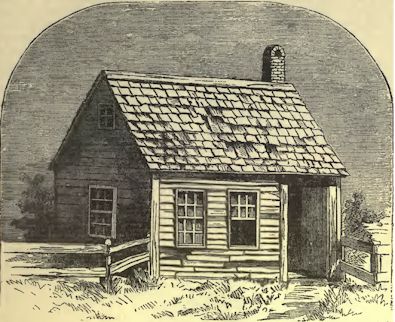The Shoemakers

Shoemakers House
Rap, rap! upon the well-worn stone,
How falls the polished hammer!
Rap, rap! the measured sound has grown
A quick and merry clamor.
Now shape the sole! now deftly curl
The glossy vamp around it,
And bless the while the bright-eyed girl
Whose gentle fingers bound it!
Rap, rap!-your stout and bluff brogan.
With footsteps slow and weary,
May wander where the sky's blue span
Shuts down upon the prairie.
On Beauty's foot your slippers glance,
By Saratoga's fountains,
Or twinkle down the summer dance
Beneath the Crystal Mountains?
John G. Whittier,
Shoemakers began to ply their trade in
this county in its first settlement. They were generally called
cordwainers or cordwinders, though those terms are not
sufficiently descriptive of their occupation, as a cordwainer
was one who sewed leather, but included the making of breeches
and other articles of clothing made of leather.
The journeymen shoemakers, and most of
them were journeymen in the early days, travelled from house to
house, and from village to village, and stopped in a family long
enough to make up a year's supply of footwear. His habits were
similar to those of the weaver and tailor, and he worked in the
house and boarded with the family while he remained. From the
hide of the cow or ox that the farmer had killed for a supply of
beef, which had been turned into leather by the tanner, the
shoemaker shod the family, fitting the boots and shoes to each
foot. Sizes, we dare say, were unknown in those earlier days.
About the middle of the eighteenth
century many of the farmers, from sides of leather tanned from
the hides of their own animals, and from leather they had
purchased, spent their dull winters in making shoes, the wives
and daughters doing the binding and closing, and the sons
helping with the sewing and in pegging after pegs began to be
used. Some worked by the fireplace in the living room of the
house, but generally a small building was built near the house
in which the men worked. These little shops were scattered all
through Essex County, and some are still to be seen in the
country. The outside view of one of these shops, and they were
nearly all of the same size and style, is shown on the preceding
page. They measured about ten by twelve feet. The inside view is
given in the accompanying engraving. The neighbors frequently
dropped in, and discussions in politics and all current topics
often became animated. Gossip found here its readiest promoters.
When the winter's work was done, or the
leather was all made up, the farmer carried his shoes to some
trade centre and sold or bartered them.
Later, some of the men in towns became
manufacturers. That is, they had a shop in which they stored
their hides and stock and the manufactured goods. There they cut
the stock,-soles, vamps, quarters, counters, tongues, lifts,
welts and rands: but the boots and shoes were made in other
places. The makers came and took away the stock, returning the
finished goods, being paid for their labor by the pair. It is
said that the first shop of this kind was in Danvers, being that
of Zerubbabel Porter. His business was established in 1786, and
he made heavy brogans for the wear of Southern slaves. The
frontispiece is a view of this shop.
About 1812, pegs, and a score of years
later the pegging machine, were invented, and then the workmen
were consolidated. Gangs did the work. Instead of one man man
making the whole of each shoe, each did a part only, one
lasting, another pegging, and so on. The small shops were
gradually abandoned, and the work was done, from the cutting of
the stock to the packing for the market, in one place.
Eventually the business congregated, forming such shoe centers
as Haverhill and Lynn.
Lynn has been noted for its shoes since
its early days, no other town in the county showing so many men
of this trade, according to the county records. The earliest
shoemakers there were Phillip Kertland and Edmund Bridges, who
came as early as 1635. In 1767 eighty thousand pairs of shoes
were made there, and in 1770 Lynn-made shoes were advertised in
London.
The journeyman shoemaker of the early
day, and the later shoe shop, which had more to do in shaping
the affairs of the region than we know, long since became a
matter of history only.
AHGP
Massachusetts

Source: The Essex Antiquarian, Volume V,
No. 3, March 1901

Hosted Free by

Come back Soon!!
Copyright August © 2011 - 2024
AHGP - The American History and Genealogy
Project.
Enjoy the work of our webmasters, provide a link, do not copy their
work.
|

